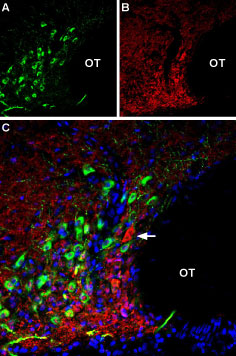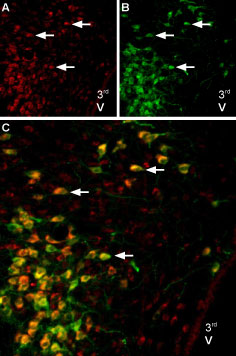Overview
- Peptide DNLNATGTNESAFNC, corresponding to amino acid residues 21-35 of rat AT2 receptor (Accession P35351). Extracellular, N-terminus.
- Perfusion fixed, frozen floating rat brain sections (1:20).
 Multiplex staining of AT2 receptor and VGLUT2 in rat supraoptic hypothalamic nucleusImmunohistochemical staining of perfusion-fixed frozen rat brain sections using Anti-Angiotensin II Receptor Type-2 (extracellular)-ATTO Fluor-488 Antibody (#AAR-012-AG), (1:60) and Anti-VGLUT2-ATTO Fluor-594 Antibody (#AGC-036-AR), (1:60). A. AT2 receptor staining (green). B. VGLUT2 staining (red). C. Merge of the two images shows a general lack of co-localization of AT2R and VGLUT2 in this part of the hypothalamus (arrow). Cell nuclei are stained with DAPI (blue).
Multiplex staining of AT2 receptor and VGLUT2 in rat supraoptic hypothalamic nucleusImmunohistochemical staining of perfusion-fixed frozen rat brain sections using Anti-Angiotensin II Receptor Type-2 (extracellular)-ATTO Fluor-488 Antibody (#AAR-012-AG), (1:60) and Anti-VGLUT2-ATTO Fluor-594 Antibody (#AGC-036-AR), (1:60). A. AT2 receptor staining (green). B. VGLUT2 staining (red). C. Merge of the two images shows a general lack of co-localization of AT2R and VGLUT2 in this part of the hypothalamus (arrow). Cell nuclei are stained with DAPI (blue).
- Live intact mouse 3T3-L1 cells (1:50).
Angiotensin II receptor type 2 or AT2 is one of the receptors that bind the octapeptide hormone Angiotensin II (Ang II).
Ang II is the peptide hormone that generates most of the known effects of the renin-angiotensin system (RAS). Ang II is generated from the angiotensinogen protein by the actions of renin, angiotensin converting enzyme (ACE) and other peptidases. Ang II has a central role in cardiovascular homeostasis by regulating vasoconstriction, renal Na+ and water readsorption. In addition, Ang II induces cell growth and proliferation and has pro-inflammatory effects.
Most of the physiological actions of Ang II are mediated by AT1 a member of the 7-transmembrane domain, G protein-coupled receptor (GPCR) superfamily. AT2 is also a GPCR, and is largely believed to have counter-regulatory roles to the ones exerted through the AT1 receptor. Hence, binding of Ang II to the AT2 receptor will result in growth arrest and apoptosis, vasodilatation and hypotension.
Although the AT2 receptor is structurally a member of the GPCR superfamily, the signaling mechanisms elicited following AT2 receptor activation are not fully clarified. Recent evidence indicates that the AT2 receptor signals through the Giα2 and the Giα3 proteins and through the activation of phosphotyrosine phosphatases such as SHP-1.
AT2 receptor distribution is more restricted than that of the AT1 receptor. The highest expression levels of AT2 have been found in the fetus, which is followed by a marked decrease shortly after birth. Nevertheless, significant AT2 receptor expression can be detected in the heart, kidney, vascular endothelial cells and brain, among others.
Application key:
Species reactivity key:

Multiplex staining of Melatonin Receptor Type 1B and AT2 Receptor in rat brainImmunohistochemical staining of perfusion-fixed frozen brain sections using Anti-Melatonin Receptor 1B (MTNR1B) Antibody (#AMR-032), (1:600) and Anti-Angiotensin II Receptor Type-2 (extracellular)-ATTO Fluor-488 Antibody (#AAR-012-AG), (1:100). A. MTNR1B staining (red) (arrows). B. The same section labeled for AT2 receptor (green). C. Merge of the two images suggests considerable co-localization in the paraventricular nucleus (arrows). For orientation, note localization with respect to 3rd ventricle (3rd V).
